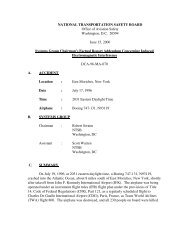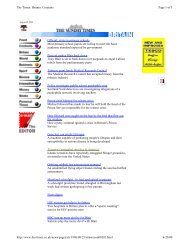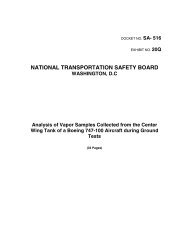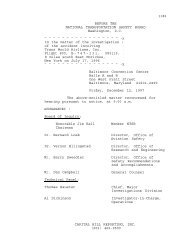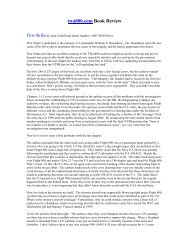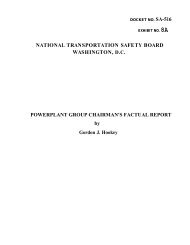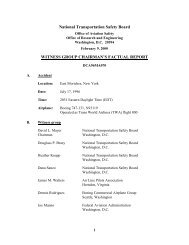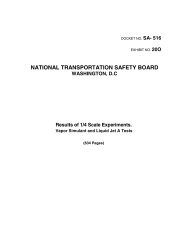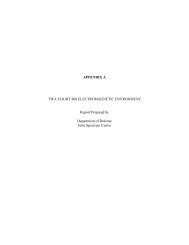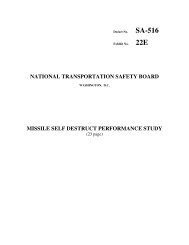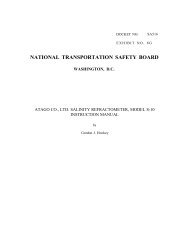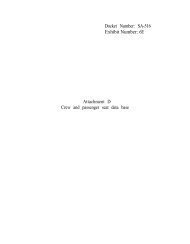Exhibit No. 11A - Group Chairman Factual Report - TWA Flight 800 ...
Exhibit No. 11A - Group Chairman Factual Report - TWA Flight 800 ...
Exhibit No. 11A - Group Chairman Factual Report - TWA Flight 800 ...
You also want an ePaper? Increase the reach of your titles
YUMPU automatically turns print PDFs into web optimized ePapers that Google loves.
All of the center wing fuel tank routine work cards, and where applicable, the non-routine work cardsfrom the last Check “D” for each of these airplanes were reviewed. <strong>No</strong>n-routine maintenance performedon the center wing fuel tanks identified repairs as follows:34●●●●●●●A torn seal in the center tank sump access door on the right side. The seal was replaced.A jettison pump was removed in order to accomplish “tank work” to remove and reinstall a checkvalve.A fuel leak was found at the bottom of the center wing fuel tank on the outboard right hand side andfour feet forward of the rear spar. The area was cleaned and the leak was sealed.Corrosion (exfoliated) was found between the web angle and center wing tank at fuselage station1241, forward of the aileron control and 43 inches below the ceiling. The corrosion was removed andthe access panels were replaced after the metal work was completed.A new APU fuel line was fabricated and replaced.Corrosion was found in the dry bay on the upper skin in places. The corrosion was removed.A fuel line was replaced in the #3 bay.An access plate was leaking on the left side. An O-ring was installed and the plate was sealed,New fittings were installed after finding a 1/4 inch crack in the bathtub fitting in the bolt hole runningfrom the fuel tank to the forward cargo at station 1001.All of the fuel pump component shop records and testing records were reviewed for each of theseairplanes, The records identified similar discrepancies and overhaul procedures as in the accidentairplane.3, FM OVERSIGHTThe Federal Aviation Administration (FAA) Principal Maintenance Inspector (PMI) currentlyassigned to the <strong>TWA</strong> certificate is located in Kansas City, MO, the Certificate Holding District Office(CHDO). The PMI was hired by the FAA in July 1988, and served as Partial Program Manager for theBoeing 747/767 fleets, and later as Assistant PMI for two years prior to his appointment as PMI onJanuary 7, 1996. The PMI has no other certificate responsibilities other than <strong>TWA</strong>, The PMI has anassistant and feels that he has sufficient support and manpower to accomplish proper oversight of thecarrier.The PMI stated that individual inspectors are assigned as Partial Program Managers (PPM) withoversight responsibility for the different make/model aircraft that <strong>TWA</strong> operates. The PPM’s and fleetsare divided as follows: DC-9, B727, B747/757/767, and L101l/MD-80. At the time of the interview, anew position, the PPM for Powerplants was being created.The PMI stated that the last National Aviation Safety Inspection Program (NASIP) for <strong>TWA</strong> began onSeptember 25, 1995, and was concluded on October 6, 1995.The NASIP for <strong>TWA</strong> was one of 141 safety audits directed by the Secretary of Transportation Theaudits were directed for all certificate holders conducting operations under 14 CFR Part 121 and Part 135aircraft with a seating capacity of 10 or more in scheduled operations. Both <strong>TWA</strong> Operations andAirworthiness issues were inspected. Areas that the NASIP team focused on were: Manuals andProcedures; Records System, Maintenance Facilities; Contractual Arrangements; Reliability Program;Continuing Analysis and Surveillance Program and Aircraft Ramp Inspection.





